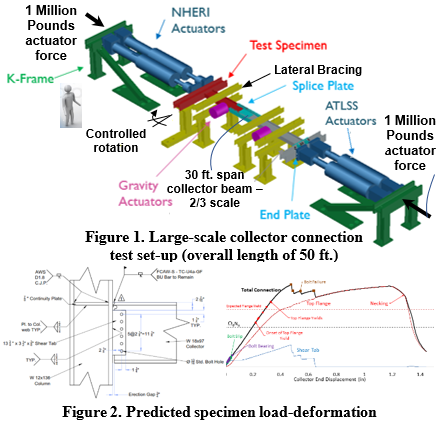CMMI 1662816 - PI Robert B. Fleischman, University of Arizona
Overview of project — This project is focused on advancing knowledge on a failure-critical yet poorly understood component of a building's seismic force resisting system, the seismic collector, with a focus on steel building structures with composite floors. The project is using nonlinear finite element analyses and large scale physical experiments of floor systems, collectors, and collector connections to develop new knowledge on the fundamental behavior of these elements, including seismic demands, force paths, limit states and key response characteristics. To achieve this goal, the project is relying on the unparalleled capabilities of the NHERI Lehigh (and NHERI UCSD) Experimental Facilities. The project outcomes will relate to new design recommendations for these elements, both for new construction and evaluation of existing structures, and the potential viability of innovative concepts.
Research methodology — The experimental technique that will be used at NHERI Lehigh is quasi-static loading. Figure 1 shows the large-scale 50-ft long test set-up for the Collector Connection Testing. The collector specimen is rotated 90 degrees from how a collector would be oriented in an actual building, in order to be able to use the NHERI Lehigh strong floor to brace the specimen. The test setup has several unique aspects that are possible due to the resources and capabilities at the NHERI Lehigh: (1) a pair of ATLSS loading actuators supply up to 1000k of collector cyclic axial force, where a hybrid control scheme involving force ratios permits varying the center of force, as determined in the analytical research; (2) a pair of NHERI reaction actuators that can use their large force and stroke capacity to simulate the rotation of the column at the collector connection due to building inter-story drift. The load patterns and loading and drift protocols will be based on the results of the analytical research (Figure 2).
Educational Impact — Anshul Agarwal, Ph.D., University of Arizona, July 2018. Developed expert knowledge of finite element package ANSYS for use in nonlinear analyses of the steel and composite members, leading to the design of test specimens. Daniel Lizarraga, M.S., University of Arizona, August 2018. Developed expert knowledge of finite element package ANSYS for use in nonlinear second order and eigenvalue analyses of the stability of steel members. Joseph Moya, M.S. Student (expected 5/2020), University of Arizona. Being trained in use of nonlinear FE package ANSYS. Maximilian Beedle, M.S. Student (expected 5/2019), Lehigh University. Training in large scale testing methods and structural steel design. Chao-Hsien Li, Ph.D. Student (expected 5/2020), University of California San Diego. Training in nonlinear analysis and shake table testing methods. Three REU students have participated in the project, gaining value experiences in large-scale testing methods, nonlinear finite element analysis. One M.S. and one Ph.D degrees have been granted to students on the project. One additional Ph.D. and two M.S. degrees are expected by to the end of the research project.
Outcomes — The major expected technical outcomes of the research program include: (1) The effect of different detailing procedures on the limit states, strength and cyclic deformation capacity of collector connections; (2) the effect of frame rotation on the cyclic performance of collector connections; (3) the controlling stability limit states and the reliable compressive strength; (4) the inherent bracing in steel composite floor systems; (5) the reliable collector load paths and seismic demands in steel composite floor systems.
The outcome of this project should serve to fill the knowledge gap that exists in the behavior of seismic collectors, and thereby lead to new code provisions that make new construction more efficient and safe, and permit practitioners to assess and retrofit vulnerable structures in the existing building stock (e.g. older hospitals). Further, the knowledge attained in this project will inform the development of innovative new systems, that instead of attempting to "out-strength" the large collector forces that could develop, instead work to limit the earthquake forces that can develop. The project will develop new computational models and data products, and lead to dissemination of the key findings to the industry and practitioners. Finally, it will lead to the education and training of several young undergraduate and graduate researchers.
